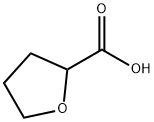2-Tetrahydrofurfurylamine
Synonym(s):2-(Aminomethyl)tetrahydrofuran
- CAS NO.:4795-29-3
- Empirical Formula: C5H11NO
- Molecular Weight: 101.15
- MDL number: MFCD00005373
- EINECS: 225-351-9
- SAFETY DATA SHEET (SDS)
- Update Date: 2024-12-18 14:15:32

What is 2-Tetrahydrofurfurylamine?
Chemical properties
Colorless to light-yellow liquid. Distilling range 150– 156C, d 0.977 (20C/20C). Combustible.
The Uses of 2-Tetrahydrofurfurylamine
Chemical intermediate, fine-grain photographic development, vulcanization accelerator.
The Uses of 2-Tetrahydrofurfurylamine
Tetrahydro-2-furanmethanamine is used in the synthesis of novel topoisomerase I targeting anti-cancer agents with mild to potent cytotoxic activity. Also used in the discovery and synthesis of orally bioavailable stearoyl-CoA desaturase 1 inhibitors
General Description
A colorless to light yellow liquid. Insoluble in water and less dense than water. Flash point between 100 - 141°F. Used to make other chemicals and as a photographic chemical.
Air & Water Reactions
Flammable. Insoluble in water.
Reactivity Profile
2-Tetrahydrofurfurylamine is an amine and alcohol. Amines are chemical bases. They neutralize acids to form salts plus water. These acid-base reactions are exothermic. The amount of heat that is evolved per mole of amine in a neutralization is largely independent of the strength of the amine as a base. Amines may be incompatible with isocyanates, halogenated organics, peroxides, phenols (acidic), epoxides, anhydrides, and acid halides. Flammable gaseous hydrogen is generated by amines in combination with strong reducing agents, such as hydrides.
Health Hazard
May cause toxic effects if inhaled or absorbed through skin. Inhalation or contact with material may irritate or burn skin and eyes. Fire will produce irritating, corrosive and/or toxic gases. Vapors may cause dizziness or suffocation. Runoff from fire control or dilution water may cause pollution.
Fire Hazard
HIGHLY FLAMMABLE: Will be easily ignited by heat, sparks or flames. Vapors may form explosive mixtures with air. Vapors may travel to source of ignition and flash back. Most vapors are heavier than air. They will spread along ground and collect in low or confined areas (sewers, basements, tanks). Vapor explosion hazard indoors, outdoors or in sewers. Runoff to sewer may create fire or explosion hazard. Containers may explode when heated. Many liquids are lighter than water.
Safety Profile
Poison by intraperitoneal route. Flammable liquid when exposed to heat or flame. When heated to decomposition it emits toxic fumes of NOx. See also MINES.
Properties of 2-Tetrahydrofurfurylamine
| Melting point: | 136 °C |
| Boiling point: | 153-154 °C744 mm Hg(lit.) |
| Density | 0.98 g/mL at 25 °C(lit.) |
| refractive index | n |
| Flash point: | 114 °F |
| storage temp. | Flammables area |
| solubility | Chloroform, Methanol |
| form | Liquid |
| pka | 9.47±0.29(Predicted) |
| color | Clear colorless to light yellow |
| explosive limit | 1.6-14.1%(V) |
| Water Solubility | miscible |
| Sensitive | Air Sensitive & Hygroscopic |
| BRN | 102729 |
| CAS DataBase Reference | 4795-29-3(CAS DataBase Reference) |
| NIST Chemistry Reference | 2-Furanmethanamine, tetrahydro-(4795-29-3) |
| EPA Substance Registry System | Tetrahydrofurfurylamine (4795-29-3) |
Safety information for 2-Tetrahydrofurfurylamine
| Signal word | Warning |
| Pictogram(s) |
 Flame Flammables GHS02  Exclamation Mark Irritant GHS07 |
| GHS Hazard Statements |
H226:Flammable liquids H315:Skin corrosion/irritation H319:Serious eye damage/eye irritation |
| Precautionary Statement Codes |
P210:Keep away from heat/sparks/open flames/hot surfaces. — No smoking. P302+P352:IF ON SKIN: wash with plenty of soap and water. P305+P351+P338:IF IN EYES: Rinse cautiously with water for several minutes. Remove contact lenses, if present and easy to do. Continuerinsing. |
Computed Descriptors for 2-Tetrahydrofurfurylamine
2-Tetrahydrofurfurylamine manufacturer
Glyra Health Care Pvt Ltd
New Products
(S)-3-Aminobutanenitrile hydrochloride 4-Methylphenylacetic acid N-Boc-D-alaninol N-BOC-D/L-ALANINOL Tert-butyl bis(2-chloroethyl)carbamate 3-Morpholino-1-(4-nitrophenyl)-5,6-dihydropyridin- 2(1H)-one Furan-2,5-Dicarboxylic Acid Tropic acid 1-Bromo-3,5-Di-Tert-Butylbenzene S-2-CHLORO PROPIONIC ACID ETHYL ISOCYANOACETATE 2-Bromo-1,3-Bis(Dimethylamino)Trimethinium Hexafluorophosphate 4-IODO BENZOIC ACID 3-NITRO-2-METHYL ANILINE 1-(2,4-DICHLOROPHENYL) ETHANAMINE (2-Hydroxyphenyl)acetonitrile 4-Bromopyrazole 2-(Cyanocyclohexyl)acetic acid 4-methoxy-3,5-dinitropyridine 1-(4-(aminomethyl)benzyl)urea hydrochloride 2-aminopropyl benzoate hydrochloride diethyl 2-(2-((tertbutoxycarbonyl)amino) ethyl)malonate tert-butyl 4- (ureidomethyl)benzylcarbamate Ethyl-2-chloro((4-methoxyphenyl)hydrazono)acetateRelated products of tetrahydrofuran


![3-[(TETRAHYDROFURAN-2-YLMETHYL)AMINO]PROPANENITRILE](https://img.chemicalbook.in/CAS/GIF/90322-18-2.gif)





You may like
-
 4795-29-3 (Tetrahydrofuran-2-yl)methylamine 99%View Details
4795-29-3 (Tetrahydrofuran-2-yl)methylamine 99%View Details
4795-29-3 -
 Tetrahydrofurfurylamine 98% CAS 4795-29-3View Details
Tetrahydrofurfurylamine 98% CAS 4795-29-3View Details
4795-29-3 -
 Tetrahydrofurfurylamine CAS 4795-29-3View Details
Tetrahydrofurfurylamine CAS 4795-29-3View Details
4795-29-3 -
 1975-50-4 98%View Details
1975-50-4 98%View Details
1975-50-4 -
 2-HYDROXY BENZYL ALCOHOL 98%View Details
2-HYDROXY BENZYL ALCOHOL 98%View Details
90-01-7 -
 2-Chloro-1,3-Bis(Dimethylamino)Trimethinium Hexafluorophosphate 221615-75-4 98%View Details
2-Chloro-1,3-Bis(Dimethylamino)Trimethinium Hexafluorophosphate 221615-75-4 98%View Details
221615-75-4 -
 14714-50-2 (2-Hydroxyphenyl)acetonitrile 98+View Details
14714-50-2 (2-Hydroxyphenyl)acetonitrile 98+View Details
14714-50-2 -
 118753-70-1 98+View Details
118753-70-1 98+View Details
118753-70-1